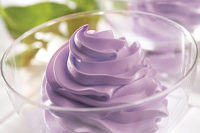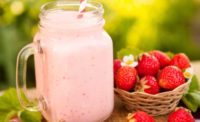Kraft, Nestlé, Hershey, General Mills, Taco Bell and Pizza Hut all have hopped on the natural-colors bandwagon. They are making the shift from tried-and-true synthetic colorants to those derived from the likes of fruits, vegetables, spices, blue-green algae and South American bugs.
The reason? Consumers want easy-to-read ingredient statements that consist of natural ingredients. It is consumers who are driving decisions about what gets formulated into their favorite yogurts, flavored milks, cheese sticks and other foods.
It’s not a simple matter of swapping one ingredient for another. Substituting natural colors for synthetics requires time and technical know-how. Given that food processors are declaring their promises so publicly, one can’t write them off as mere marketing gambits. On the contrary, this steady stream of conversions represents a long-term transformation that may well be significant.
Make that “very significant,” corrected Steve Morris, general manager for Sensient Colors, St. Louis. “We still sell more synthetic colors than natural colors, but naturals make up a significant portion of our business and are growing at double digits.”
Consumers may be demanding natural colors in their foods and beverages, but it’s worth noting that that’s not exactly what the industry is giving them—at least not from a legal or regulatory standpoint.
“To be clear,” said Georges Bergen, senior manager, regulatory affairs, DSM Nutritional Products, Parsippany, N.J., “FDA only sets a distinction between certified colors — that is, your FD&Cs — and those colors exempt from certification” as per 21 CFR 73. It’s the latter, he said, “that the average consumer typically associates with natural,” he said. As far as FDA is concerned, though, “whether a color originates from a so-called natural or synthetic source, any product containing an ingredient specifically added to impart color has to be labeled as such.”
Be that as it may, consumers’ perceptions still shape their reality. And Marlena Hidlay, associate marketing manager at DSM, has found that consumers are “definitely becoming savvier about the ingredients in their foods and beverages, and more health conscious about what they’re putting in their mouths.”
A nation of label readers
The 2013 Study of Consumer Awareness & Perceptions of Food Coloring Ingredients (Multisponsor Inc.) found 67% of health-conscious consumers reading product labels to determine which ingredients color their food and drink choices.
Clean labels are their rallying cry, “and naturally sourced colors fit nicely into that space,” Hidlay said. Moreover, with shoppers and bloggers petitioning online “for ‘healthier’ reformulations of their favorite products,” she said, they’re “making waves in the media” that push manufacturers towards natural colorants.
Food manufacturers turn to their colorant suppliers for suitable options.
“We’ve been spending much more time than in the past assisting customers who want to remove FD&C dyes,” said Brian Sethness, sales and marketing manager, Sethness Products Co., Skokie, Ill. “When companies see their competitors removing artificial colors,” he said, “they’ve been quickly following suit.”
Stephen J. Lauro, president of colorMaker, Anaheim, Calif., noted that most companies have already phased artificial colors out of the new-product-development pipeline. All the hubbub over major-brand reformulations may thus be “a reaffirmation of what the R&D department has been doing quietly for the past few years —namely, working exclusively with natural colors,” Lauro said.
Dairy’s history with natural colorants goes way back. Christian Hjortholm Steffensen, marketing manager – North America for Chr. Hansen Inc., Milwaukee, noted that his company introduced its first natural color at the 1876 World’s Fair in Philadelphia. It was a butter color derived from annatto.
Making dairy and colors work together
Just because natural colors and dairy have been around the block, however, doesn’t mean they are always in for a smooth ride. Dairy can be a frustrating medium in which to deploy natural colorants, and the fault for that belongs partly with dairy, and partly with the colorants themselves.
Compared to synthetics, naturals like anthocyanins show greater susceptibility to pH-driven hue changes, said Todd Katz, senior technical marketing & applications manager at DSM. Other naturals, like carotenoids, are more susceptible to oxidation than artificial colors and require additional protection, such as the addition of ascorbic acid or enhanced packaging, he said.
Water-soluble annatto-based colors (in particular those with high norbixin contents) can precipitate at low pH and shade-shift from yellow to pink, said Carol Locey, director, product management, colors, for Kalsec of Kalamazoo, Mich. “Careful selection of the appropriate annatto formulation will mitigate the chance of pinking reactions.”
Another challenge involves finding naturally sourced colorants that produce just the right shade. This is no small matter in dairy, where frozen desserts, ice creams and beverages send powerful cues about flavor and quality via their brightly colored appearance.
Brianna Clark, a Chr. Hansen scientist for dairy product development & applications, noted that natural browns are in “high demand” for numerous product lines, like dulce de leche ice cream and caramel macchiato beverages. But processors are on the hunt for 4-MeI-free options. This ingredient (4-methylimidazole) is on California’s Prop. 65 list of possible carcinogens and found in Class III and IV caramel colors.
While the natural spectrum is expanding, the environment in dairy applications can still challenge even the latest colorants. Yogurt offers a case in point.
“Each yogurt varies so greatly from the next, with differing moisture levels, processes, cultures. Some have fruit preps included, while others do not,” said Morris of Sensient Colors.
The mere presence of those fruit preps raises the risk for color bleed, especially with red hues. And while carmine enjoyed a longstanding reputation for staying put, the current “bug phobia,” as Emina Goodman, a technical support specialist who works in the industry dubbed it, has brands looking for alternate solutions that perform just as well as carmine but aren’t extracted from crushed cochineal insects. (Adding to carmine’s woes: it’s not vegan, halal or kosher.)
Even shelf-stable fluid milk can foil attempts at natural coloring. “Because of the high pasteurization temperatures used in its production and its ambient storage conditions,” long-life milk can knock out less-stable natural colors, explained DSM’s Katz.
Back up and ask: Do we need color?
“The first, and perhaps most important, question an R&D department should ask is: Do we need any color at all?” said Lauro of colorMaker. “This is particularly true for dairies. There are numerous vanilla shakes, Cheddar cheeses and coffee-flavored smoothies that don’t need any color, natural or artificial.”
Lauro advises customers to consider natural colors at the beginning of the product-development process. That is easier to do if you’re formulating a product from scratch, but not so much if you’re replacing synthetics in an existing one. As Kalsec’s Locey said, starting naturally “gives you the opportunity to see which hues are attainable with natural colors instead of trying to match an unnatural-looking synthetic color after the fact.”
But in Goodman’s experience, “the challenges are the same” whether starting fresh or subbing out synthetics. Water activity, pH, process and packaging all remain issues; “the only benefit to starting from scratch,” she said, “would be that consumers have a preconceived notion of what the product should look like. With iconic brands like Kraft Mac n’ Cheese, they expect it to look a certain way, and it can take longer to match that appearance than to create a new appearance.”
“And can we get a sample of the product base to test the possible solutions?” Goodman added. “What’s its stability? Do you have fruit prep in your product, which will require a specific formulation to avoid color bleed? What flexibility do you have to alter the base if necessary?” These are all worthy questions, she said, because “No base is the same as the next.”
Easing the path
Nor is any natural colorant. They’re certainly not the same as the options available even a decade ago, and the change has been resoundingly for the better. Nathalie Pauleau, business manager, food and beverage, Naturex, Avignon, France, noted that her company launched two new products earlier this year to replace FD&C Red 40 and carmine in yogurt. A deodorized anthocyanin-based colorant extracted from red radish gives stirred yogurt a strawberry-red shade without introducing the vegetable’s characteristic sulfur note. The second enhances the red of a strawberry fruit prep while preventing color bleed into the yogurt base. The color solution prevents the migration of colors between layers, she said.
As a natural replacement for artificial lakes — colorants that dye by dispersion — Pauleau’s company offers a range of pigments that also avert fat-to-fat migration. The oil-dispersible colorants are handy in fat-based products like white compound coatings for ice cream.
Dairy manufacturers still have to do their homework, and they have to be willing to go back to the drawing board when the beta version doesn’t quite hit its target. But they shouldn’t give up on the shift toward natural colors.
“Don’t give up,” Lauro said. “Change is hard, and numerous hurdles will have to be jumped. But it can be done.”
Making the switch to natural colors: 7 questions for dairy processors and suppliers to answer
- What color do you want, and what color are you starting with? Also important — especially when replacing a synthetic in an existing formulation — is: How close does the natural color need to match?
- Are you looking for a liquid or powdered colorant? “A few natural colors are only available in one form or another,” said Stephen J. Lauro of colorMaker.
- What solubility properties does the colorant need? “Almost all natural colors begin life as a liquid extract from a fruit or vegetable,” Lauro said. They’re either oil-soluble or water-soluble. To make beet juice workable as a natural red in cheese, an emulsifier will be necessary to disperse the water-soluble color throughout the fat of the cheese, he said.
- What about processing parameters, especially how hot and for how long? Ready-to-drink milk beverages undergo very high-heat processing. Beyond times and temperatures, it’s also wise to inventory all the steps in the manufacturing process, the order in which they proceed and how they might affect a colorant. For example, “Does the mixing process limit incorporation of oxygen?” asked Todd Katz of DSM. The answer could make or break an oxidation-labile color.
- What’s the packaging system, and how much light does it permit? “Some natural colors fade to brown when exposed to light,” Lauro said. Turmeric literally disappears, he said. Then again, “Many dairy products have a limited shelf life that can easily be met while using natural colors anyway,” said Kalsec’s Carol Locey. So the effect of packaging often isn’t a limiting factor.
- What is the shelf life? It can run from days to weeks to more than a year. Lauro said even under ideal circumstances, the natural color will fade away.
- What are the special dietary requirements of the finished food?” “That is, do we need kosher, halal, organic or non-GMO credentials, among others?” Lauro asked.






